Chevrolet Volt (2016-2019) fuse box and relay Diagrams

The Chevrolet Volt (2016-2019) is a plug-in hybrid vehicle that combines electric and gasoline power for enhanced efficiency and extended range. As a technologically advanced vehicle, its electrical system is complex, and the fuse box and relay components are crucial to its operation.
The fuse box in the Chevrolet Volt houses various fuses that protect different electrical circuits throughout the vehicle. These circuits manage essential systems such as the battery, electric motor, infotainment, lighting, and climate control. The fuse box is typically located in two main areas: inside the cabin (often under the dashboard) and in the engine compartment. Each fuse is designed to “blow” or break the circuit if there’s an overload or short circuit, preventing damage to the vehicle’s more expensive and critical components.
Relays are also a vital part of the Volt’s electrical system. These are electronically operated switches that control high-current circuits. In the Chevrolet Volt, relays are responsible for managing power to components such as the electric motor, fuel pump, cooling fans, and various other high-demand electrical systems. By allowing a low-power signal to control a high-power circuit, relays help ensure that the vehicle’s electrical systems function reliably without overloading the smaller switches and wiring within the car.
Maintaining the fuse box and relays in the Chevrolet Volt is essential for the vehicle’s reliability. Regular checks can help identify blown fuses or faulty relays before they lead to more significant issues, such as a non-functional electric motor, lighting problems, or issues with the vehicle’s hybrid powertrain. If a fuse or relay fails, it should be replaced with the correct specification component to ensure the vehicle’s electrical systems operate as intended.
Understanding the role of the fuse box and relays in the Chevrolet Volt is key to maintaining its complex electrical system, especially in a plug-in hybrid where electrical efficiency and reliability are paramount. Proper maintenance and timely replacement of these components can help avoid unexpected failures and keep the vehicle running smoothly, ensuring both the electric and gasoline systems work harmoniously.
MUST READ: DYI – How to Check Car Fuses?
(2016-2019) Chevrolet Volt fuse box and relay with Diagram
WARNING
- Never replace a fuse with one that has a higher amperage rating.
- A fuse with a too-high amperage could damage the electrical part and cause a fire.
- On no account should fuses be repaired (e.g. patched up with tin foil or wire) as this may cause serious damage elsewhere in the electrical circuit or cause a fire.
- If a fuse blows repeatedly, do not keep replacing it. Instead, have the cause for the repeated short circuit or overload tracked and fixed.
- Terminal and harness assignments for individual connectors will vary depending on vehicle equipment level, model, and market.
Chevrolet Volt 2016-2019 fuse assignment
- Cigar lighter (power outlet) fuses in the Chevrolet Volt are the circuit breakers CB1 (Front auxiliary power outlet) and CB2 (Rear auxiliary power outlet) in the Instrument panel fuse box.
Year of production: from 2016, 2017, 2018, 2019
Instrument Panel Fuse Box
Fuse box location
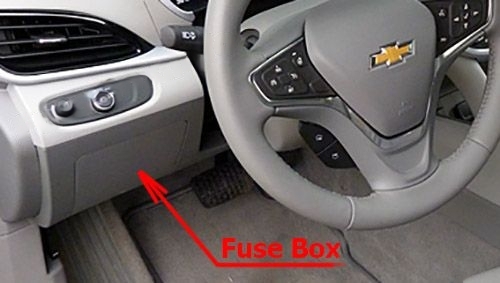
It is located on the driver’s side of the instrument panel, behind the cover.
Fuse box diagram

Assignment of the fuses and relays in the Instrument Panel (2016-2019)
| № | Usage |
|---|---|
| F1 | Empty |
| F2 | Empty |
| F3 | Empty |
| F4 | Heater, ventilation, and air conditioning blower |
| F5 | Body control module 2 |
| F6 | Empty |
| F7 | 2016-2017: Empty 2018-2019: CGM |
| F8 | Body control module 3 |
| F9 | Fuel power pump module |
| F10 | Empty |
| F11 | Empty |
| F12 | Empty |
| F13 | Empty |
| F14 | Empty |
| F15 | Empty |
| F16 | Empty |
| F17 | Data link connector |
| F18 | Body control module 7 |
| F19 | Cluster |
| F20 | Body control module 1 |
| F21 | Body control module 4 |
| F22 | Body control module 6 |
| F23 | OnStar |
| F24 | Airbag |
| F25 | Display |
| F26 | 2016-2018: Infotainment 2019: Universal serial bus |
| F27 | Empty |
| F28 | Empty |
| F29 | Overhead console |
| F30 | Radio/Infotainment |
| F31 | Steering wheel controls |
| F32 | Body control module 8 |
| F33 | Heater, ventilation, and air conditioning/ Integrated light solar sensor |
| F34 | Passive entry/ Passive start |
| F35 | Rear closure |
| F36 | Charger |
| F37 | Empty |
| F38 | Empty |
| F39 | Empty |
| F40 | Empty |
| F41 | Empty |
| F42 | Empty |
| Circuit Breakers | |
| CB1 | Front auxiliary power outlet |
| CB2 | Rear auxiliary power outlet |
| Relays | |
| R1 | Empty |
| R2 | Retained accessory power |
| R3 | Hatch |
| R4 | Empty |
| R5 | Empty |
Engine Compartment Fuse Box
Fuse box location
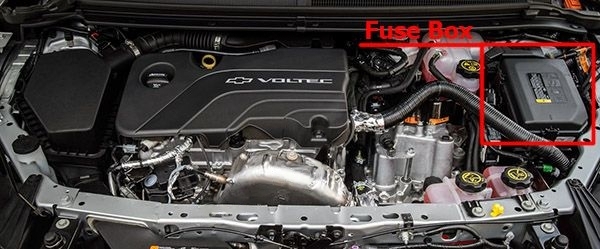
It is located in the engine compartment on the driver’s side.
Fuse box diagram
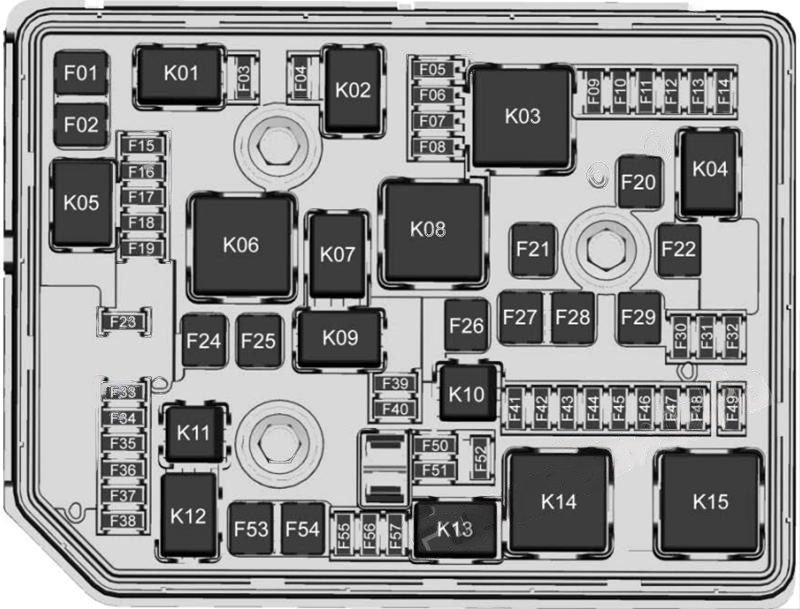
Assignment of the fuses and relays in the Engine Compartment (2016-2019)
| № | Usage |
|---|---|
| F01 | Empty |
| F02 | Empty |
| F03 | Non walk home |
| F04 | Engine control module |
| F05 | Aeroshutter |
| F06 | Traction power inverter module 1 |
| F07 | Traction power inverter module 2 |
| F08 | Engine control module |
| F09 | Air conditioning control module |
| F10 | Vehicle integration control module |
| F11 | Electric brake boost |
| F12 | Rechargeable energy storage system |
| F13 | Cabin heater control module |
| F14 | Coolant heater control module |
| F15 | Emissions |
| F16 | Ignition coils |
| F17 | Engine control module |
| F18 | Empty |
| F19 | Empty |
| F20 | Electric brake boost |
| F21 | Front wiper |
| F22 | Antilock brake system pump |
| F23 | Front windshield wiper |
| F24 | Empty |
| F25 | Empty |
| F26 | Empty |
| F27 | Antilock brake system module |
| F28 | Left power window |
| F29 | Rear window defogger |
| F30 | Heated mirrors |
| F31 | Empty |
| F32 | Variable functions |
| F33 | Empty |
| F34 | Horn |
| F35 | Coolant rechargeable energy storage system |
| F36 | Right high-beam headlamp |
| F37 | Left high-beam headlamp |
| F38 | Empty |
| F39 | Empty |
| F40 | Empty |
| F41 | Miscellaneous run, crank |
| F42 | Run, crank 3 |
| F43 | Empty |
| F44 | Voltage current temperature module run, crank |
| F45 | Heated steering wheel |
| F46 | Vehicle integration control module run, crank |
| F47 | Empty |
| F48 | Empty |
| F49 | Empty |
| F50 | Empty |
| F51 | Empty |
| F52 | Engine control module/Traction power inverter module |
| F53 | Left cooling fan |
| F54 | Right cooling fan |
| F55 | Electric pump |
| F56 | Empty |
| F57 | Empty |
| Relays | |
| K01 | Empty |
| K02 | Empty |
| K03 | Engine control module |
| K04 | 2016-2018: Empty 2019: Pedestrian friendly alert function |
| K05 | Empty |
| K06 | Empty |
| K07 | Empty |
| K08 | Empty |
| K09 | Empty |
| K10 | Empty |
| K11 | Empty |
| K12 | High beam headlamps |
| K13 | Empty |
| K14 | Run, crank |
| K15 | Rear window defogger |
| K16 | Horn PCB relay |
| K17 | Empty |
| K18 | Empty |
| K19 | Coolant pump PCB relay |
| K20 | Empty |
| K21 | Empty |
| K22 | Front washer |
| K23 | Empty |
Rear Compartment Fuse Box
Fuse box location
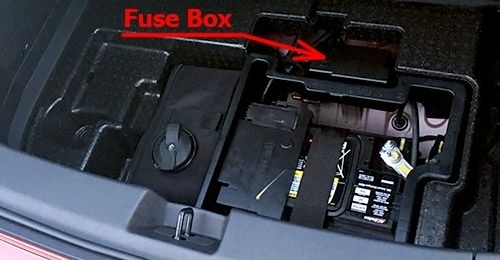
It is located in the center of the rear compartment beneath the load floor.
Fuse box diagram
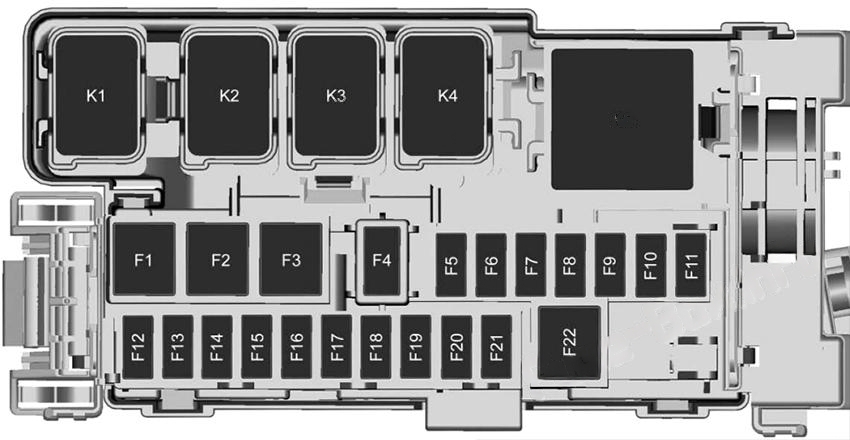
Assignment of the fuses and relays in the Luggage Compartment (2016-2019)
| № | Usage |
|---|---|
| F1 | 2016-2018: Empty 2019: Driver power seat |
| F2 | Empty |
| F3 | Empty |
| F4 | 2016-2018: Empty 2019: Driver lumbar control/Keypass |
| F5 | Pedestrian protection |
| F6 | On-board charger module |
| F7 | Front heated seat |
| F8 | Front heated seat |
| F9 | Driver door/Mirror switches |
| F10 | Empty |
| F11 | Amplifier |
| F12 | Steering wheel switch backlighting |
| F13 | Empty |
| F14 | Empty |
| F15 | Empty |
| F16 | Empty |
| F17 | Empty |
| F18 | Empty |
| F19 | Obstacle detection |
| F20 | Fuel |
| F21 | Rear heated seat |
| F22 | Right power windows |
| Relays | |
| K1 | Empty |
| K2 | Empty |
| K3 | Empty |
| K4 | Empty |
| K5 | Empty |
Conclusion
For owners and enthusiasts of classic Chevrolet Volt 2016-2019, understanding the fuse box and relay systems is essential for vehicle maintenance. Regular inspection and maintenance of these components helped ensure the vehicle’s longevity and reliability, preserving its status as a symbol of Chevrolet’s craftsmanship and innovation in the automotive industry during that era.